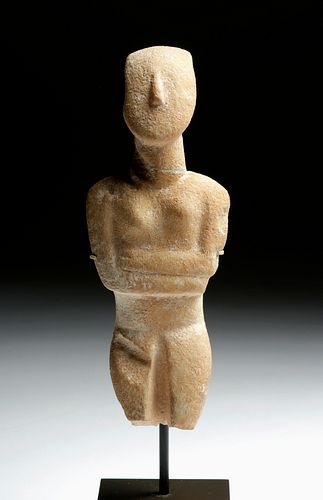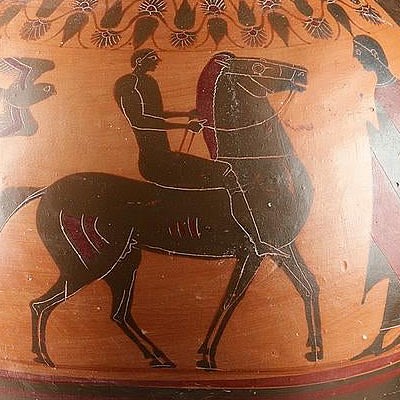Greek Cycladic Marble Figure Spedos Type, ex-Christie's
Lot 14a
About Seller
Artemis Fine Arts
686 S Taylor Ave, Ste 106
Louisville, CO 80027
United States
Selling antiquities, ancient and ethnographic art online since 1993, Artemis Gallery specializes in Classical Antiquities (Egyptian, Greek, Roman, Near Eastern), Asian, Pre-Columbian, African / Tribal / Oceanographic art. Our extensive inventory includes pottery, stone, metal, wood, glass and textil...Read more
Categories
Estimate:
$125,000 - $150,000
Absentee vs Live bid
Two ways to bid:
- Leave a max absentee bid and the platform will bid on your behalf up to your maximum bid during the live auction.
- Bid live during the auction and your bids will be submitted real-time to the auctioneer.
Bid Increments
| Price | Bid Increment |
|---|---|
| $0 | $25 |
| $300 | $50 |
| $1,000 | $100 |
| $2,000 | $250 |
| $5,000 | $500 |
| $10,000 | $1,000 |
| $20,000 | $2,500 |
| $50,000 | $5,000 |
| $100,000 | $10,000 |
| $200,000 | $20,000 |
About Auction
By Artemis Fine Arts
Jun 4, 2020
Set Reminder
2020-06-04 10:00:00
2020-06-04 10:00:00
America/New_York
Bidsquare
Bidsquare : Exceptional Antiquities, Asian, Ethnographic
https://www.bidsquare.com/auctions/artemis-gallery/exceptional-antiquities-asian-ethnographic-5185
An important one-day auction featuring museum-worthy examples of Egyptian, Greek, Roman, Etruscan, Near Eastern, Far East / Asian, Pre-Columbian, African / Tribal, Oceanic, Native American, Spanish Colonial, Russian, Fossils, Ancient Jewelry, Fine Art, so much more! Artemis Fine Arts info@artemisgallery.com
An important one-day auction featuring museum-worthy examples of Egyptian, Greek, Roman, Etruscan, Near Eastern, Far East / Asian, Pre-Columbian, African / Tribal, Oceanic, Native American, Spanish Colonial, Russian, Fossils, Ancient Jewelry, Fine Art, so much more! Artemis Fine Arts info@artemisgallery.com
- Lot Description
Ancient Greece, Cyclades, Early Spedos, ca. 2600 to 2500 BCE. Finely carved from marble, a reclining female figure with her arms crossed, typical of the sculpture of the Cyclades in the mid-2000s BCE known as the Spedos variety, this name derived from an Early Cycladic cemetery on the island of Naxos. This canonical type is characterized by an elongated slender body with folded arms, a lyre- or U-shaped head, and a deeply incised cleft between the legs. The anatomical details are characteristically minimized presenting an abstract, geometric quality. Incisions on the body delineate the arms crossed over the chest, and define the abdomen, pubic triangle, and spine. The breasts are gently rendered as well. On the face, the low relief nose is pronounced, and it is possible that other details originally may have been delineated with brightly colored pigments. When viewed from the side, the back is straight and continues the line of the neck, while the head is dramatically arched and the legs flex forward. Size: 7.25" H (18.4 cm); 9.625" H (24.4 cm) on included custom stand.
This piece sold for GBP 62,500 ($82,512.62) at Christie's London - Sale 12239 - 6 July 2016, Lot 37.
According to the Christie's Lot Essay, "It has been suggested that the grooves at the neck and upper right thigh of the present lot may be the result of deliberate damage in antiquity. Some Cycladic figures have been discovered in graves purposefully broken, at the neck and at the knees, with the three parts of the figure then carefully arranged. This sort of damage most likely had a ritual context, though its precise meaning is still unknown. Thimme has suggested that Cycladic female figures 'were conceived as images of divine beings and specifically intended for the grave: the female figures represent a divine mistress of life and death, who will secure for the deceased rebirth in another world' - it is not apparent what benefits would be reaped by deliberately damaging a figure imbued with such potent power (O. Höckmann, 'Cycladic Religion', in J. Thimme (ed.), Art and Culture of the Cyclades, Chicago, 1977, p. 42)."
Provenance: private East Coast, USA collection; ex-Christie's, London Antiquities auction (sale 12239, July 6, 2016, lot 37); ex-private United Kingdom collection, acquired from K.J. Hewett, London in the 1960s
All items legal to buy/sell under U.S. Statute covering cultural patrimony Code 2600, CHAPTER 14, and are guaranteed to be as described or your money back.
A Certificate of Authenticity will accompany all winning bids.
We ship worldwide and handle all shipping in-house for your convenience.
#156105Old chips to neck, left arm, right shoulder, right hip and knee as shown. Lower legs missing. Head reattached at the neck. This said, scholars believe that such figures were purposefully broken during antiquity. (See discussion of this in Christies lot essay mentioned in our description.) Normal surface abrasions. Nice earthen/mineral deposits that have developed over the ages.Condition
- Shipping Info
-
All shipping is handled in-house for your convenience. Your invoice from Artemis Gallery will include shipping calculation instructions. If in doubt, please inquire BEFORE bidding for estimated shipping costs for individual items.
-
- Buyer's Premium



 EUR
EUR CAD
CAD AUD
AUD GBP
GBP MXN
MXN HKD
HKD CNY
CNY MYR
MYR SEK
SEK SGD
SGD CHF
CHF THB
THB


















